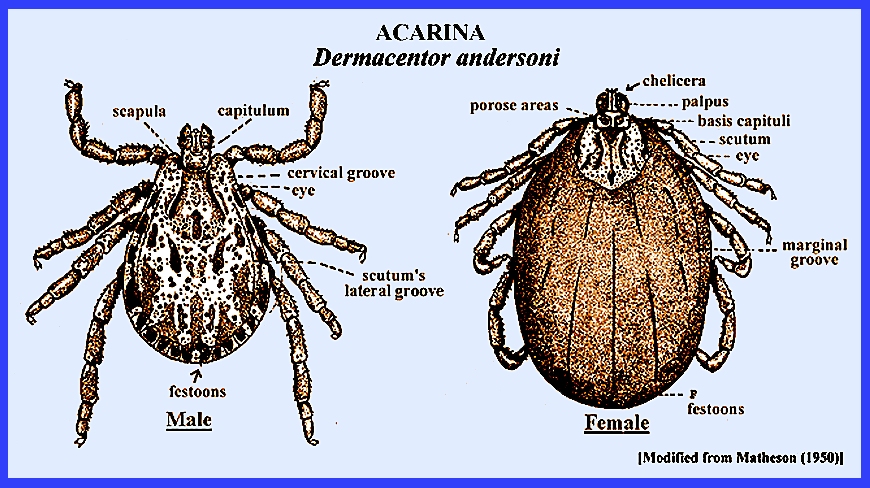File: <coloradotickfever.htm> <Medical Index> <General Index> Site Description Glossary <Navigate
to Home>
|
COLORODO TICK FEVER (Contact) Please
CLICK on
Image & underlined links for details: Symptoms of
the disease do not involve a rash and the fever is of the remittent
type. It is rarely fatal. The nymphs
and larvae draw blood from small mammals such as squirrels, rabbits,
chipmunks and woodrats. Both the
ticks and small mammals serve as reservoir hosts. Large mammals, such as humans, deer and cattle become infected
if infected ticks also draw blood from them.
Service (2008) notes that both transstadial and transovarial
transmission may occur. Colorado Tick Fever -
Life Cycle = = = = = = = = = = = =
= = = = = = = = Key References: <medvet.ref.htm> <Hexapoda> [Additional references may be found at: MELVYL Library] Camicas, J. L., J. . Hervy, F. Adam & P. C.
Morel. 1998. The ticks of the world (Acarida,
Ixodida): Nomenclature, Described
Stages, Hosts,
Distribution. Paris: Editions
de l'ORSTOM. Francy DB, Moore LG, Smith GC, Jakob WL, Taylor SA,
Calisher CH. 1988. Epizootic vesicular stomatitis in Colorado, 1982:
Isolation of virus from
insects collected along the northern Colorado Rocky Mountain Front Range.
Journal of Medical Entomology 25: 343-347 Gammons, M. & G. Salam. 2002. Tick
removal. Amer. Fam. Physician
66: 643-45. Gothe, R., K. Kunze
& H. Hoogstraal. 1979. The mechanisms of pathogenicity in the
tick paralyses. J. Med. Ent. 16: 357-69. Hoogstraal, H.
1966. Ticks in relation to
human diseases caused by viruses.
Ann. Rev. Ent. 11: 261-308. Legner, E. F. 1995.
Biological control of Diptera of medical and veterinary
importance. J. Vector Ecology 20(1):
59_120. Legner, E. F. 2000.
Biological control of aquatic Diptera. p. 847_870.
Contributions to a Manual of Palaearctic Diptera, Vol.
1, Science Herald, Budapest. 978 p. Matheson, R. 1950.
Medical Entomology. Comstock
Publ. Co, Inc. 610 p. Needham, G. R. & P. D. Teel. 1991.
Off-host physiological ecology of ixodid ticks. Ann. Rev. Ent. 36: 313-52. Parola, P. & D. Raoult. 2001. Tick-borne
typhuses. IN: The Encyclopedia of arthropod-transmitted
Infections of Man and Domesticated Animals.
ed. M. W. Service, Wallingford: CABI:
pp. 516-24. Service, M.
2008. Medical Entomology For
Students. Cambridge Univ. Press. 289 p Sonenshine, D. E., R. S. Lane & W. L. Nicholson.
2002. Ticks (Ixodida). IN:
Medical & Veterinary Entomology, ed. G. Mullen & L.
Durden,
Ambsterdam Acad. Press.
pp 517-58. Sonenshine, D. E. & T. N. Mather (eds.) 1994.
Ecological Dynamics of Tick-Borne Zoonoses. Oxford Univ. Press, New York. Steer, A., J. Coburn & L. Glickstein. 2005.
Lyme borreliosis. IN: Tick-Borne Diseases of Humans, ed. J. L.
Goodman, D. T. Dennis & D. E. Sonenshine. Washington, DC: ASM Press. |
